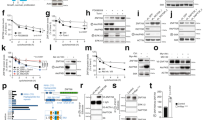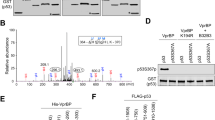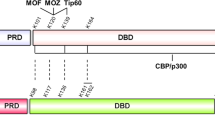Abstract
The tumour suppressor p53 induces cellular senescence in response to oncogenic signals1. p53 activity is modulated by protein stability and post-translational modification, including phosphorylation and acetylation2. The mechanism of p53 activation by oncogenes remains largely unknown. Here we report that the tumour suppressor PML regulates the p53 response to oncogenic signals. We found that oncogenic Ras upregulates PML expression, and overexpression of PML induces senescence in a p53-dependent manner. p53 is acetylated at lysine 382 upon Ras expression, an event that is essential for its biological function. Ras induces re-localization of p53 and the CBP acetyltransferase within the PML nuclear bodies and induces the formation of a trimeric p53–PML–CBP complex. Lastly, Ras-induced p53 acetylation, p53–CBP complex stabilization and senescence are lost in PML-/-fibroblasts. Our data establish a link between PML and p53 and indicate that integrity of the PML bodies is required for p53 acetylation and senescence upon oncogene expression.
This is a preview of subscription content, access via your institution
Access options
Subscribe to this journal
Receive 51 print issues and online access
$199.00 per year
only $3.90 per issue
Buy this article
- Purchase on SpringerLink
- Instant access to full article PDF
Prices may be subject to local taxes which are calculated during checkout





Similar content being viewed by others
References
Serrano, M., Lin, A. W., McCurrach, M. E., Beach, D. & Lowe, S. W. Oncogenic ras provokes premature cell senescence associated with accumulation of p53 and p16INK4a. Cell 88, 593–602 ( 1997).
Giaccia, A. J. & Kastan, M. B. The complexity of p53 modulation: emerging patterns from divergent signals. Genes Dev. 12, 2973–2983 (1998).
de The, H., Chomienne, C., Lanotte, M., Degos, L. & Dejean, A. The t(15;17) translocation of acute promyelocytic leukaemia fuses the retinoic acid receptor alpha gene to a novel transcribed locus. Nature 347, 558– 561 (1990).
Borrow, J., Goddard, A. D., Sheer, D. & Solomon, E. Molecular analysis of acute promyelocytic leukemia breakpoint cluster region on chromosome 17. Science 249, 1577– 1580 (1990).
Fagioli, M. et al. Cooperation between the RING + B1-B2 and coiled-coil domains of PML is necessary for its effects on cell survival. Oncogene 16, 2905–2913 ( 1998).
Le, X. F., Yang, P. & Chang, K. S. Analysis of the growth and transformation suppressor domains of promyelocytic leukemia gene, PML. J. Biol. Chem. 271, 130–135 (1996).
Liu, J. H., Mu, Z. M. & Chang, K. S. PML suppresses oncogenic transformation of NIH/3T3 cells by activated neu. J. Exp. Med. 181, 1965 –1973 (1995).
Wang, Z. G. et al. Role of PML in cell growth and the retinoic acid pathway. Science 279, 1547–1551 (1998).
Dimri, G. P. et al. A biomarker that identifies senescent human cells in culture and in aging skin in vivo. Proc. Natl Acad. Sci. USA 92, 9363–9367 (1995).
Dyck, J. A. et al. A novel macromolecular structure is a target of the promyelocyte-retinoic acid receptor oncoprotein. Cell 76, 333– 343 (1994).
Metz, T., Harris, A. W. & Adams, J. M. Absence of p53 allows direct immortalization of hematopoietic cells by the myc and raf oncogenes. Cell 82, 29–36 (1995).
Harvey, M. et al. In vitro growth characteristics of embryo fibroblasts isolated from p53- deficient mice. Oncogene 8, 2457–2467 (1993).
Alcorta, D. A. et al. Involvement of the cyclin-dependent kinase inhibitor p16 (INK4a) in replicative senescence of normal human fibroblasts. Proc. Natl Acad. Sci. USA 93, 13742–13747 (1996).
el-Deiry, W. S. et al. WAF1, a potential mediator of p53 tumor suppression. Cell 75, 817–825 ( 1993).
Sherr, C. J. & Weber, J. D. The ARF/p53 pathway. Curr. Opin. Genet. Dev. 10, 94–99 (2000).
Sakaguchi, K. et al. DNA damage activates p53 through a phosphorylation-acetylation cascade. Genes Dev. 12, 2831– 2841 (1998).
Liu, L. et al. p53 sites acetylated in vitro by PCAF and p300 are acetylated in vivo in response to DNA damage. Mol. Cell. Biol. 19, 1202–1209 (1999).
Doucas, V., Tini, M., Egan, D. A. & Evans, R. M. Modulation of CREB binding protein function by the promyelocytic (PML) oncoprotein suggests a role for nuclear bodies in hormone signaling. Proc. Natl Acad. Sci. USA 96, 2627–2632 ( 1999).
Grignani, F. et al. High-efficiency gene transfer and selection of human hematopoietic progenitor cells with a hybrid EBV/retroviral vector expressing the green fluorescence protein. Cancer Res. 58, 14 –19 (1998).
Gu, W. & Roeder, R. G. Activation of p53 sequence-specific DNA binding by acetylation of the p53 C-terminal domain. Cell 90, 595–606 (1997).
Lill, N. L., Grossman, S. R., Ginsberg, D., DeCaprio, J. & Livingston, D. M. Binding and modulation of p53 by p300/CBP coactivators. Nature 387, 823–827 (1997).
LaMorte, V. J., Dyck, J. A., Ochs, R. L. & Evans, R. M. Localization of nascent RNA and CREB binding protein with the PML- containing nuclear body. Proc. Natl Acad. Sci. USA 95, 4991– 4996 (1998).
Ishov, A. M. et al. PML is critical for ND10 formation and recruits the PML-interacting protein daxx to this nuclear structure when modified by SUMO-1. J. Cell Biol. 147, 221–234 (1999).
Zhong, S. et al. Role of SUMO-1 modified PML in nuclear body formation. Blood 95, 2748–2752 ( 2000).
Quignon, F. et al. PML induces a novel caspase-independent death process. Nature Genet. 20, 259–265 (1998).
Sherr, C. J. Tumor surveillance via the ARF-p53 pathway. Genes Dev. 12, 2984–2991 (1998).
Livingstone, L. R. et al. Altered cell cycle arrest and gene amplification potential accompany loss of wild-type p53. Cell 70, 923–935 (1992).
Yin, Y., Tainsky, M. A., Bischoff, F. Z., Strong, L. C. & Wahl, G. M. Wild-type p53 restores cell-cycle control and inhibits gene amplification in cells with mutant p53 alleles. Cell 70, 937–948 (1992).
Zhong, S. et al. A role for PML and the nuclear body in genomic stability. Oncogene 18, 7941–7947 ( 1999).
Grignani, F. et al. Fusion proteins of the retinoic acid receptor-alpha recruit histone deacetylase in promyelocytic leukaemia. Nature 391, 815–818 (1998).
Acknowledgements
We thank Y. Nakatani, M. Sciurpi and A. Ariesi for reagents, discussion and technical help. This work was supported by grants from MURST, AIRC and the EC.
Author information
Authors and Affiliations
Corresponding author
Rights and permissions
About this article
Cite this article
Pearson, M., Carbone, R., Sebastiani, C. et al. PML regulates p53 acetylation and premature senescence induced by oncogenic Ras. Nature 406, 207–210 (2000). https://doi.org/10.1038/35018127
Received:
Accepted:
Issue Date:
DOI: https://doi.org/10.1038/35018127
This article is cited by
-
The interactions between PML nuclear bodies and small and medium size DNA viruses
Virology Journal (2023)
-
A stress-induced cilium-to-PML-NB route drives senescence initiation
Nature Communications (2023)
-
The Role of p53 in HIV Infection
Current HIV/AIDS Reports (2023)
-
TRAIL-receptor 2—a novel negative regulator of p53
Cell Death & Disease (2021)
-
Autophagy regulation by acetylation—implications for neurodegenerative diseases
Experimental & Molecular Medicine (2021)



